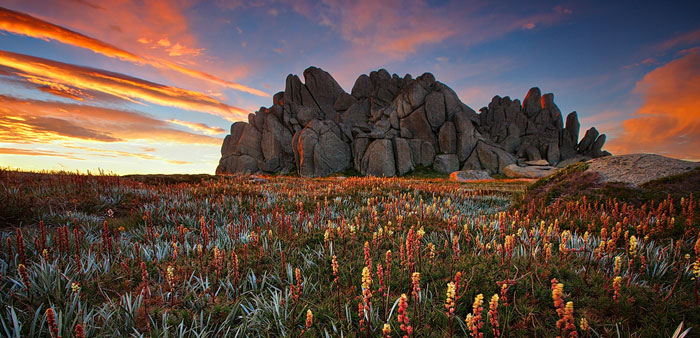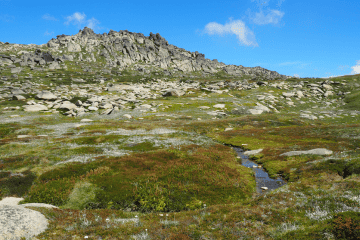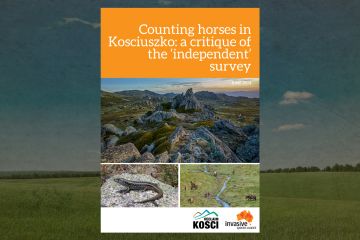
A strong new plan to tackle the growing damage of feral horses in Kosciuszko National Park has been released. It is liable to be controversial, and we need you to register your support for the plan by 19 August 2016.
In a major step forward, the new Draft Wild Horse Management Plan for Kosciuszko National Park sets an ambitious target – a 90% population reduction of feral horses in the park.
Current estimates put the number of feral horses in the park at 6000. The NSW National Parks and Wildlife Service (NPWS) aims to reduce that to 600 in 20 years through a number of methods, including the use of ground shooting for the first time in more than a decade.
- Feral horses have been increasingly identified as an environmental threat to the unique, sensitive and UNESCO recognised alpine environment of Kosciuszko National Park.
- They threaten endangered plants and animals including the corroboree frog, broad-toothed rat and anemone buttercup, and compete with native animals for food.
- Feral horses themselves also suffer from growing population numbers, with large numbers of horses starving to death.
[toggle title_open=”How to make a submission” title_closed=”How to make a submission” hide=”yes” border=”yes” style=”default” excerpt_length=”0″ read_more_text=”Read More” read_less_text=”Read Less” include_excerpt_html=”no”]
The Draft Wild Horse Management Plan should be supported as major step forward in protecting Kosciuszko National Park from feral horse damage. While the goal should be applauded, it’s implementation would be improved with the addition of aerial shooting and a more rapid horse population reduction.
Visit the Office of Environment & Heritage website to make your submission by 19 August 2016 supporting the Draft Wild Horse Management Plan. We suggest you use the points below in your submission:
What to say in your submission
In your own words, make the following points:
- Support the general aim of the Draft Wild Horse Management Plan to reduce the feral horse population in Kosciuszko National Park by 90% to no more than 600. You may wish to see the national park free of feral horses.
- Explain the importance of protecting Kosciuszko National Park from the environmental damage caused by feral horses.
- Support on-ground shooting of feral horses in areas where trapping is not possible.
- Suggest that the plan would be improved by the use of aerial shooting and that the goal to reduce the Kosciuszko National Park feral horse population to 600 should occur over a period of five years rather than 20.
[/toggle]
The parks service has removed some heat from the debate by taking aerial shooting off the table.
Aerial shooting is considered by feral animal control experts as the most humane and effective means of reducing large numbers of horses and has been conditionally endorsed by the RSPCA. It is fiercely opposed by horse advocates.
We hope the removal of aerial shooting as an option opens the door for conservationists, horse lobby groups and cultural heritage groups to work with the parks service towards a widely supported solution to the feral horse problem.
Draft plan
The Draft Wild Horse Management Plan is diplomatic, ambitious and well constructed. It considers the concerns of all stakeholders – environmental, heritage and welfare concerns – and proposes a compromise in an attempt to meet all those concerns.
In particular, the horse population will be removed from areas of concern including major roadways to prevent car fatalities, fragile sphagnum bogs and fens as well as treeless high altitude alpine areas. It will also prevent feral horses from reaching areas they do not currently inhabit.
The aim is for a future where culling is not necessary. By reducing feral horse numbers to a manageable population any future overflow can theoretically be removed and adopted out of the park rather than culled. While the Invasive Species Council disagrees with the goal of maintaining horses in a national park, we endorse the strong focus of getting on with protecting the park.
Reducing the population to 600 feral horses and removing them from sensitive areas will make great strides in protecting the park and its fragile alpine ecosystems from further damage.
Where the plan falls short
We have two main criticisms of the plan. Firstly, it lacks definitive detail on how feral horses will be excluded from sensitive areas or how they will be prevented from invading new areas.
Secondly, the plan rejects aerial shooting. Without this control measure it is unlikely the target and therefore the desired environmental outcomes will be reached.
Aerial shooting is a recommended option in the 2016 review of the 2008 Horse Management Plan to meet environmental and welfare outcomes.
The review evaluated the efficacy of the previous plan to reduce feral horse numbers, humanely and effectively, and recommended aerial shooting as necessary to achieve the desired population reduction.
It also recommended aerial shooting as a humane way of dealing with feral horses, which suffer from protracted stress when being transported over long distances and ongoing stress when being ‘rehomed’. Of the 82% of wild horses that couldn’t be rehomed, many were trucked more than 500km to abattoirs and knackeries.
Both ground shooting and aerial shooting provide faster and more effective approaches to reducing feral horse numbers. The 20-year goal to reach the target of 600 horses is an extremely long period and may mean the target is never reached.
How to make a submission
The Draft Wild Horse Management Plan should be supported as major step forward in protecting Kosciuszko National Park from feral horse damage. While the goal should be applauded, it’s implementation would be improved with the addition of aerial shooting and a more rapid horse population reduction.
Visit the Office of Environment & Heritage website to make your submission supporting the Draft Wild Horse Management Plan. We suggest you draw on the information below and use the points in the final section in your submission.
The context
Feral horses have been increasingly identified as an environmental threat to the unique, sensitive and UNESCO recognised alpine environment of Kosciuszko National Park and treated as a pest species.
Successive plans have failed to reduce the feral horse population to protect the values of the park, most recently the 2008 Horse Management Plan. The 2016 review of this plan highlights that without the use of lethal, on-site techniques population reduction cannot be met and welfare outcomes (for the feral horses) were poorer than desired.
What we’re protecting
The new draft plan highlights all the reasons feral horse numbers need to be reduced. The threats are summarised below:
- Feral horses in Kosciuszko National Park are damaging sensitive, unique and UNESCO recognised ecosystems.
- Feral horses are threatening with survival already endangered plants and animals, e.g. the corroborree frog, broad-toothed rat and the anemone buttercup. Feral horses also compete with native grazing animals for food which may lead to territorial disputes with horses and their death when food is scarce.
- Feral horses are threatening the water security of the Murray-Darling Basin by causing erosion and damaging the ability of natural ecosystems to filter water and provide clean water for the Hydroelectric Scheme.
- Feral horse welfare is threatened by over-population and damage to the environment resulting in large numbers of horses starving to death. Additionally, non-lethal on-site control techniques and subsequent transport lead to drawn out distress for feral horses, which can be improved by quicker methods such as on- ground and aerial shooting.
The plan protects the values of Kosciuszko National Park by:
- Permanently reducing feral horse numbers to 600, thereby protecting most of the park’s values.
- Using a number of techniques to reduce feral horses such as on-ground shooting, aerial mustering and trapping and removal of feral horses (to abattoirs or for rehoming). The use of shooting is necessary to reduce sufficient horse numbers.
- Removing feral horses from sensitive ecosystems and preventing invasion of formerly horse-free areas.
What to say in your submission
In your own words, make the following points:
- Support the general aim of the Draft Wild Horse Management Plan to reduce the feral horse population in Kosciuszko National Park by 90% to no more than 600. You may wish to see the national park free of feral horses.
- Explain the importance of protecting Kosciuszko National Park from the environmental damage caused by feral horses.
- Support on-ground shooting of feral horses in areas where trapping is not possible.
- Suggest that the plan would be improved by the use of aerial shooting and that the goal to reduce the Kosciuszko National Park feral horse population to 600 should occur over a period of five years rather than 20.
[Ed: Amendment 2 Aug 2016: The reference to cannibalistic horses in two places was amended. While cannibalism by two horses was observed, it is not clear whether this behaviour occurs widely. The reference was changed to remove mention of cannibalism and replaced with a reference to the large number of horses that may die of starvation.]




